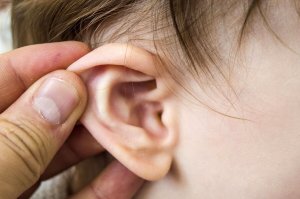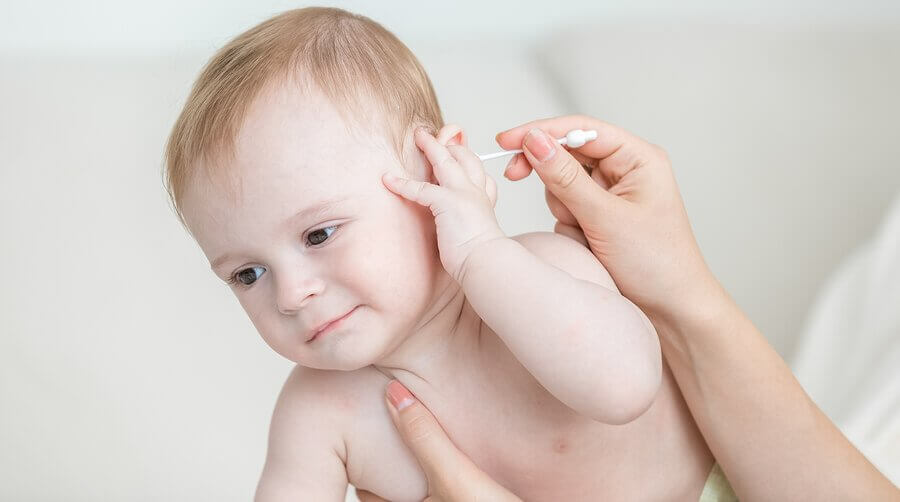Common Types of Ear Infections in Children

As parents, you worry about any discomfort that your babies may feel. This is because they can’t explain the kind of pain or discomfort they’re experiencing, especially in their ears. Therefore, it’s important to know the common types of ear infections in children so you can detect them quickly.
There are two types of ear infections that affect babies: otitis media and otitis externa. The first one affects the middle ear due to fluid buildup behind the eardrum from colds. The second kind causes inflammation of the external auditory canal, either from water getting in or injuries.
How to know if your child has an ear infection?
It’s essential that parents pay attention to their children’s attitudes and even the smallest change in their behavior. If they touch their ears in strange ways or have unpleasant odors, they may have an infection.
In addition, if they have other symptoms, like loss of appetite, crying, flu, and tantrums, they can be indicators that something is wrong.
Ear infections in children or babies can be acute or chronic. Acute ear infections are spontaneous and generally painful. Chronic ear infections last for a long time. These infections are common in little ones because it’s very easy for their Eustachian tubes to clog.
Symptoms of ear infections in children
When children have some kind of infection in their ear, they’ll have various symptoms that can make parents worry. Therefore, it’s important to take them to the pediatrician who can create a treatment. These are the most common symptoms:
- High temperature. Fevers and colds often cause ear infections.
- Touching their ears a lot. If babies touch their ears excessively, are irritable or cry when they do it, it’s most likely because they hurt.

- Vomiting or diarrhea: Viruses that cause ear infections can also affect kids’ stomachs.
- Loss of appetite. Generally, kids feel unwell because of their ear pain.
- Yellow or whitish liquid discharge. It’s not common for this to happen in all children, but it’s a definite sign of infection.
- Bad odor in their ears. You’ll notice this when you hug or hold your baby.
- Ear pain. This especially happens when they try to sleep. Usually, kids feel more pain when lying down.
Most common causes of ear infections in children
The most common cause is the entry of fluids in the middle ear from a cold. Since the Eustachian tubes are blocked, the fluids can’t get out. Therefore, the fluid goes into the ear, which can cause inflammation, pain and fever.
On the other hand, otitis externa occurs in children when water enters their ear from swimming. Then, it gets aggravated if you clean it too hard with cotton swabs.
When swimming, your ears are exposed to high humidity for a long time. When you use swabs too rough, you can cause inflammation in the external auditory canal.
“It’s essential that parents pay attention to their children’s attitudes and even the smallest change in their behavior. If they touch their ears in strange ways or have unpleasant odors, they may have an infection.”
How to prevent ear infections in children
The first step is to make sure your children are all up to date with vaccines. These help prevent some diseases that can cause ear infections. For example, they prevent certain bacteria like Streptococcus pneumoniae, Haemophilus influenzae, or Moraxella catarrhalis. In addition, they prevent viruses like rhinovirus, influenza and adenovirus, among others.
In addition, it’s important to breastfeed for at least the first 6 months. Experts point out that through breast milk, mothers transfer antibodies that strengthens babies’ immune systems. Therefore, this helps them be less likely to develop ear infections.
Finally, keep babies away from cigarette smoke and tobacco. Children of adult smokers are more likely to get ear infections and have hearing problems compared to children whose parents don’t smoke.

When to consult a specialist
You should go to the pediatrician for an ear exam as soon as you see that your baby is uncomfortable.
It’s important to do this so your doctor can determine what kind of ear infection he has. Then, he’ll prescribe the necessary treatment, depending on the type of infection. Of course, you shouldn’t do any treatment without your doctor’s approval.
Ultimately, it’s important to keep track of the infection by going to check-ups to make sure that it’s disappeared completely and that the ears are doing well. A strong or untreated infection can actually perforate babies’ eardrums and cause hearing loss.
As parents, you worry about any discomfort that your babies may feel. This is because they can’t explain the kind of pain or discomfort they’re experiencing, especially in their ears. Therefore, it’s important to know the common types of ear infections in children so you can detect them quickly.
There are two types of ear infections that affect babies: otitis media and otitis externa. The first one affects the middle ear due to fluid buildup behind the eardrum from colds. The second kind causes inflammation of the external auditory canal, either from water getting in or injuries.
How to know if your child has an ear infection?
It’s essential that parents pay attention to their children’s attitudes and even the smallest change in their behavior. If they touch their ears in strange ways or have unpleasant odors, they may have an infection.
In addition, if they have other symptoms, like loss of appetite, crying, flu, and tantrums, they can be indicators that something is wrong.
Ear infections in children or babies can be acute or chronic. Acute ear infections are spontaneous and generally painful. Chronic ear infections last for a long time. These infections are common in little ones because it’s very easy for their Eustachian tubes to clog.
Symptoms of ear infections in children
When children have some kind of infection in their ear, they’ll have various symptoms that can make parents worry. Therefore, it’s important to take them to the pediatrician who can create a treatment. These are the most common symptoms:
- High temperature. Fevers and colds often cause ear infections.
- Touching their ears a lot. If babies touch their ears excessively, are irritable or cry when they do it, it’s most likely because they hurt.

- Vomiting or diarrhea: Viruses that cause ear infections can also affect kids’ stomachs.
- Loss of appetite. Generally, kids feel unwell because of their ear pain.
- Yellow or whitish liquid discharge. It’s not common for this to happen in all children, but it’s a definite sign of infection.
- Bad odor in their ears. You’ll notice this when you hug or hold your baby.
- Ear pain. This especially happens when they try to sleep. Usually, kids feel more pain when lying down.
Most common causes of ear infections in children
The most common cause is the entry of fluids in the middle ear from a cold. Since the Eustachian tubes are blocked, the fluids can’t get out. Therefore, the fluid goes into the ear, which can cause inflammation, pain and fever.
On the other hand, otitis externa occurs in children when water enters their ear from swimming. Then, it gets aggravated if you clean it too hard with cotton swabs.
When swimming, your ears are exposed to high humidity for a long time. When you use swabs too rough, you can cause inflammation in the external auditory canal.
“It’s essential that parents pay attention to their children’s attitudes and even the smallest change in their behavior. If they touch their ears in strange ways or have unpleasant odors, they may have an infection.”
How to prevent ear infections in children
The first step is to make sure your children are all up to date with vaccines. These help prevent some diseases that can cause ear infections. For example, they prevent certain bacteria like Streptococcus pneumoniae, Haemophilus influenzae, or Moraxella catarrhalis. In addition, they prevent viruses like rhinovirus, influenza and adenovirus, among others.
In addition, it’s important to breastfeed for at least the first 6 months. Experts point out that through breast milk, mothers transfer antibodies that strengthens babies’ immune systems. Therefore, this helps them be less likely to develop ear infections.
Finally, keep babies away from cigarette smoke and tobacco. Children of adult smokers are more likely to get ear infections and have hearing problems compared to children whose parents don’t smoke.

When to consult a specialist
You should go to the pediatrician for an ear exam as soon as you see that your baby is uncomfortable.
It’s important to do this so your doctor can determine what kind of ear infection he has. Then, he’ll prescribe the necessary treatment, depending on the type of infection. Of course, you shouldn’t do any treatment without your doctor’s approval.
Ultimately, it’s important to keep track of the infection by going to check-ups to make sure that it’s disappeared completely and that the ears are doing well. A strong or untreated infection can actually perforate babies’ eardrums and cause hearing loss.
All cited sources were thoroughly reviewed by our team to ensure their quality, reliability, currency, and validity. The bibliography of this article was considered reliable and of academic or scientific accuracy.
- Infecciones del oído medio [Internet]. Kidshealth.org. [citado 24 de enero de 2022]. Disponible en: https://kidshealth.org/es/parents/otitis-media.html
- Larach F, Astorquiza C. OTITIS EXTERNA: DIAGNÓSTICO Y MANEJO PRÁCTICO. Rev médica Clín Las Condes [Internet]. 2016;27(6):898-904. Disponible en: http://dx.doi.org/10.1016/j.rmclc.2016.11.019
- Reyes Romero H, Navarro Rojas P, Jakowlew A, Reyes Barrios H. Otitis media bacteriana. Antibiot infecc [Internet]. 2003 [citado el 24 de enero de 2022];11-23. Disponible en: https://pesquisa.bvsalud.org/portal/resource/pt/lil-399677
This text is provided for informational purposes only and does not replace consultation with a professional. If in doubt, consult your specialist.








